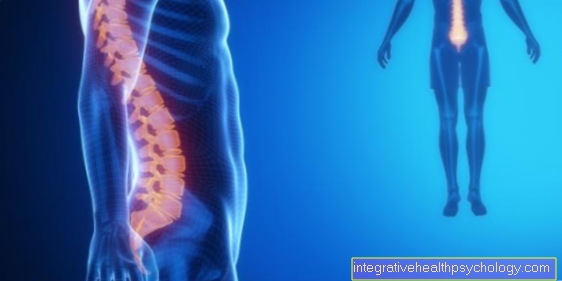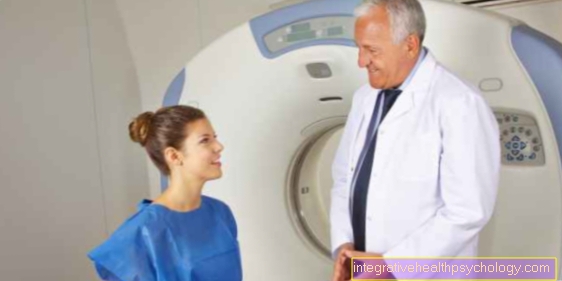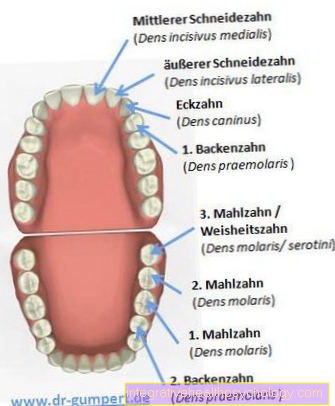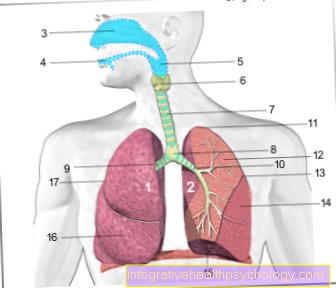MRI for claustrophobia - what options are there?
Synonyms
MRI for claustrophobia
General information about MRI
In order to be able to assess different questions and diseases as precisely as possible, an examination with an MRI machine is necessary in many cases. With the help of MRT, structures of the body can be displayed which cannot be adequately depicted with the help of other imaging methods such as computed tomography or X-rays.
Read also on this topic MRI - How far do I have to put my head in?

At a MRI machine it is usually an elongated device with a hollow tube in the middle. The patient to be examined is usually pushed into this tube with the request to remain as still as possible during the examination.
For some examinations it may even be necessary for the patient to be examined to hold their breath for a few seconds while the images are being created.
An MRI machine creates the required images with the help of magnetic fields and thus without the use of harmful radiation. A problem that relatively many patients with the MRI examination However, it is necessary to lie completely still in the narrow tube until all images have been taken.
Especially for patients with Claustrophobia this is a very big challenge.
Such Claustrophobia can be approached with different methods. For example, sedatives can be administered or even a short one anesthesia for the time during the examination.
Some practices and clinics also offer an examination in modern, so-called open MRTs, in which the problem of claustrophobia takes a back seat.
In some cases, however, there is simply a lack of information about the implementation and mode of operation of an MRI device, which leads to claustrophobia in the tube. In these cases, the practice or clinic team should carry out a comprehensive explanation of the upcoming procedure in order to remove any fears, especially claustrophobia, in advance.
For some patients, their claustrophobia makes it impossible to perform an MRI scan. In some cases, other imaging techniques can be used. In other cases this is not possible, whereby a diagnostic or progress monitoring disadvantage may arise for the person concerned.
In any case, people who fear that they will suffer from claustrophobia during the MRI scan can and should inform themselves about individual alternatives and possible solutions from the treating physician. In most cases, a satisfactory solution can be found that at the same time takes into account the fears of the patient and enables the medical diagnosis to be carried out.
The editors also recommend: MRI for overweight people
Procedure / implementation

Patients suffering from claustrophobia and who are about to undergo an examination in an MRI machine are confronted with a problem. Nowadays there are a number of different ways to enable the examination for people with claustrophobia.
First of all, it is important which body structure is to be examined with the MRI machine. For example, if only the knee joint is to be examined, in many cases it is not necessary for the whole body to lie in the narrow tube.
In the case of complex questions that affect the entire organism or large parts of the body, the solution is of course not possible. But even in these cases, alternatives to the normal implementation of an MRI can be offered.
It helps in many patients if a sedative is taken shortly before the examination. The doctors in the hospital can provide individual advice if so requested. If the claustrophobia is so pronounced that an examination is not possible even after taking a sedative, anesthesia may be considered.
As with anesthesia for an operation, there are various ways of performing this. Which anesthesia is most suitable for each individual should best be discussed with the treating anesthetist. They are also responsible for the procedure when performing the anesthesia in the MRI machine.
Another option is to use a different MRI machine. On the one hand, there are devices that have a wider tube and can thus significantly reduce the feeling of tightness during the examination.
On the other hand, so-called open MRTs, which can do without a tube completely, have come into use more and more frequently in recent years. Instead of the tube, the patient to be examined now has to lie between two plates so that the MRT images can be created.
As a restriction, it must be said that not all statutory health insurances fully cover the costs of the MRT examination and the image quality is still (worse) below that of a modern closed MRI.
Read more on the subject at: MRI procedure
Sedative: Dormicum®
At Dormicum® is the trade name of a drug from Hoffmann-La Roche with the active ingredient Midazolam.
The drug falls under the commercially available narcotics in Germany. Among other things, it is used for upcoming MRI examinations, for example when patients are under Claustrophobia and therefore the examination can only be carried out correctly with Dormicum®. The group to which the drug Dormicum® belongs is called in pharmacy short-acting benzodiazepines designated. Compared to other sedatives, Dormicum® has a relatively short effect and is therefore perfect for use before the MRI examination.
As the effect also occurs very quickly after ingestion, it is well suited for people who are afraid of the examination. If the wish is expressed that a sedative should be administered before the examination, Dormicum® is used in most cases.
Also for children there is the possibility of using Dormicum® for temporary calming by adjusting the individual dosage of the drug. Nevertheless, the use for the examination should not be taken lightly, because, as for any drug, that also applies to Dormicum® Side effects may occur.
Since the sedative affects structures in the brain works, the side effects are sometimes not insignificant. Only if it is actually not possible to carry out the MRT examination without the use of a sedative should the use of Dormicum be considered® to be thought about. There should be an individual discussion with the attending physician, in which he explains the risks of taking Dormicum® and the side effects that may occur.
anesthesia
In addition to other available options, which can be used in patients with claustrophobia prior to an MRI examination, a anesthesia are used. This is usually a Short anesthesia, which only lasts for the period of the investigation. Often this will be Short anesthesia with Propofol carried out. Such anesthesia are more common than in claustrophobic patients, for example during a Colonoscopy applied.
Since an anesthetic is not insignificant Side effects may have, the implementation of such comes only in very rare cases for use.
In addition to claustrophobic patients, short-term anesthesia are also often used in children if the examination does not appear to be possible without the anesthetic. Usually such short anesthesia are used Medication performed, which are administered intravenously. Before the anesthesia, the treating patient must be sober, i.e. have not eaten or drunk anything for a few hours.
A few moments after the administration of the medication, the anesthesia takes effect and the patient concerned is left for the duration of the examination artificially ventilated.
In most cases the examination only takes 15-30 minutes, which is why the time under anesthesia is usually very short. After the examination, the patient is usually referred to a so-called Recovery room brought and from one Anesthetists supervised until independent breathing is possible again. Participation in road traffic or the use of heavy equipment should still be avoided for the day.
For patients with claustrophobia, anesthesia is often the last resort to have the planned MRI examination carried out. Most clinics and some radiological practices offer short anesthesia for this group of patients.
However, due to the possible side effects, all other options should be discussed beforehand. This can best be done in a conversation with the treating doctor on site.
Please also read our interesting topics:
- anesthesia
- Anesthesia in children
and - Side effects of anesthesia
Open MRI
The open MRI is a name for certain new MRT devices that do not require the use of narrow tubes for examination.
Nevertheless, the patient to be examined must two relatively close opposite plates lie between themso that the MRI images can be created.
Most of the patients who suffer from claustrophobia and therefore avoid an MRI examination, the new devices help enormously. Particularly because it is possible with these devices to have an accompanying person not only in the same room during the examination, but even within sight, patients will be with them Claustrophobia and above all Childrenwho are afraid of the examination helped a lot. In addition to being used for people who suffer from claustrophobia, MRI machines of this type can also be used to ensure that certain Interventions during the examination be performed.
The advantage is that the effect can be made visible in the body when the procedure is being carried out. The image quality of these open MRTs has become better and better in recent years and nowadays comes close to, but not equal to, the MRTs with the usual tunnel design.
Read more on this topic at: open MRI













.jpg)















